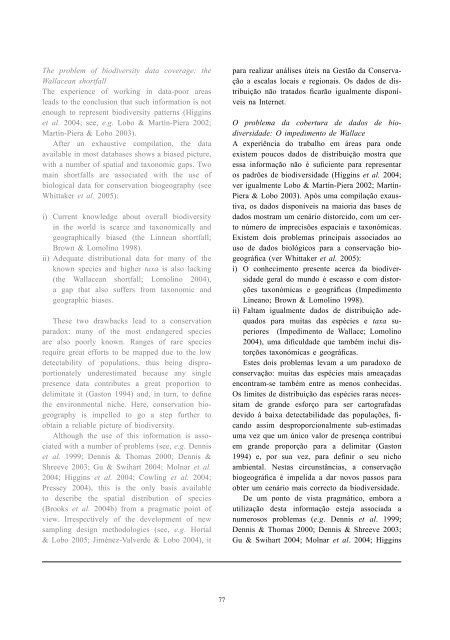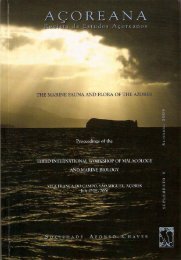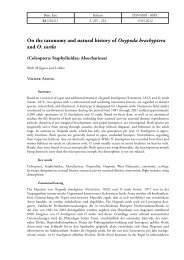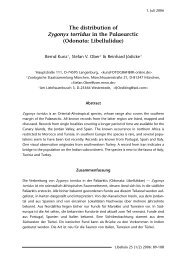(eds.) (2005). - Portal da Biodiversidade dos Açores - Universidade ...
(eds.) (2005). - Portal da Biodiversidade dos Açores - Universidade ...
(eds.) (2005). - Portal da Biodiversidade dos Açores - Universidade ...
You also want an ePaper? Increase the reach of your titles
YUMPU automatically turns print PDFs into web optimized ePapers that Google loves.
The problem of biodiversity <strong>da</strong>ta coverage: the<br />
Wallacean shortfall<br />
The experience of working in <strong>da</strong>ta-poor areas<br />
leads to the conclusion that such information is not<br />
enough to represent biodiversity patterns (Higgins<br />
et al. 2004; see, e.g. Lobo & Martín-Piera 2002;<br />
Martín-Piera & Lobo 2003).<br />
After an exhaustive compilation, the <strong>da</strong>ta<br />
available in most <strong>da</strong>tabases shows a biased picture,<br />
with a number of spatial and taxonomic gaps. Two<br />
main shortfalls are associated with the use of<br />
biological <strong>da</strong>ta for conservation biogeography (see<br />
Whittaker et al. <strong>2005</strong>):<br />
i) Current knowledge about overall biodiversity<br />
in the world is scarce and taxonomically and<br />
geographically biased (the Linnean shortfall;<br />
Brown & Lomolino 1998).<br />
ii) Adequate distributional <strong>da</strong>ta for many of the<br />
known species and higher taxa is also lacking<br />
(the Wallacean shortfall; Lomolino 2004),<br />
a gap that also suffers from taxonomic and<br />
geographic biases.<br />
These two drawbacks lead to a conservation<br />
paradox: many of the most en<strong>da</strong>ngered species<br />
are also poorly known. Ranges of rare species<br />
require great efforts to be mapped due to the low<br />
detectability of populations, thus being disproportionately<br />
underestimated because any single<br />
presence <strong>da</strong>ta contributes a great proportion to<br />
delimitate it (Gaston 1994) and, in turn, to define<br />
the environmental niche. Here, conservation biogeography<br />
is impelled to go a step further to<br />
obtain a reliable picture of biodiversity.<br />
Although the use of this information is associated<br />
with a number of problems (see, e.g. Dennis<br />
et al. 1999; Dennis & Thomas 2000; Dennis &<br />
Shreeve 2003; Gu & Swihart 2004; Molnar et al.<br />
2004; Higgins et al. 2004; Cowling et al. 2004;<br />
Pressey 2004), this is the only basis available<br />
to describe the spatial distribution of species<br />
(Brooks et al. 2004b) from a pragmatic point of<br />
view. Irrespectively of the development of new<br />
sampling design methodologies (see, e.g. Hortal<br />
& Lobo <strong>2005</strong>; Jiménez-Valverde & Lobo 2004), it<br />
77<br />
para realizar análises úteis na Gestão <strong>da</strong> Conservação<br />
a escalas locais e regionais. Os <strong>da</strong><strong>dos</strong> de distribuição<br />
não trata<strong>dos</strong> ficarão igualmente disponíveis<br />
na Internet.<br />
O problema <strong>da</strong> cobertura de <strong>da</strong><strong>dos</strong> de biodiversi<strong>da</strong>de:<br />
O impedimento de Wallace<br />
A experiência do trabalho em áreas para onde<br />
existem poucos <strong>da</strong><strong>dos</strong> de distribuição mostra que<br />
essa informação não é suficiente para representar<br />
os padrões de biodiversi<strong>da</strong>de (Higgins et al. 2004;<br />
ver igualmente Lobo & Martín-Piera 2002; Martín-<br />
Piera & Lobo 2003). Após uma compilação exaustiva,<br />
os <strong>da</strong><strong>dos</strong> disponíveis na maioria <strong>da</strong>s bases de<br />
<strong>da</strong><strong>dos</strong> mostram um cenário distorcido, com um certo<br />
número de imprecisões espaciais e taxonómicas.<br />
Existem dois problemas principais associa<strong>dos</strong> ao<br />
uso de <strong>da</strong><strong>dos</strong> biológicos para a conservação biogeográfica<br />
(ver Whittaker et al. <strong>2005</strong>):<br />
i) O conhecimento presente acerca <strong>da</strong> biodiversi<strong>da</strong>de<br />
geral do mundo é escasso e com distorções<br />
taxonómicas e geográficas (Impedimento<br />
Lineano; Brown & Lomolino 1998).<br />
ii) Faltam igualmente <strong>da</strong><strong>dos</strong> de distribuição adequa<strong>dos</strong><br />
para muitas <strong>da</strong>s espécies e taxa superiores<br />
(Impedimento de Wallace; Lomolino<br />
2004), uma dificul<strong>da</strong>de que também inclui distorções<br />
taxonómicas e geográficas.<br />
Estes dois problemas levam a um paradoxo de<br />
conservação: muitas <strong>da</strong>s espécies mais ameaça<strong>da</strong>s<br />
encontram-se também entre as menos conheci<strong>da</strong>s.<br />
Os limites de distribuição <strong>da</strong>s espécies raras necessitam<br />
de grande esforço para ser cartografa<strong>da</strong>s<br />
devido à baixa detectabili<strong>da</strong>de <strong>da</strong>s populações, ficando<br />
assim desproporcionalmente sub-estima<strong>da</strong>s<br />
uma vez que um único valor de presença contribui<br />
em grande proporção para a delimitar (Gaston<br />
1994) e, por sua vez, para definir o seu nicho<br />
ambiental. Nestas circunstâncias, a conservação<br />
biogeográfica é impeli<strong>da</strong> a <strong>da</strong>r novos passos para<br />
obter um cenário mais correcto <strong>da</strong> biodiversi<strong>da</strong>de.<br />
De um ponto de vista pragmático, embora a<br />
utilização desta informação esteja associa<strong>da</strong> a<br />
numerosos problemas (e.g. Dennis et al. 1999;<br />
Dennis & Thomas 2000; Dennis & Shreeve 2003;<br />
Gu & Swihart 2004; Molnar et al. 2004; Higgins

















